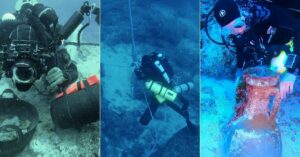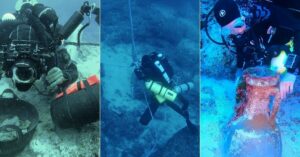
Ports Of Indiana Gets Approval To Establish 1st Container Port On Lake Michigan
July 5, 2024
IMO Urges Immediate Action To Aid Clean-Up Efforts In Yemen After Rubymar Sinking
July 5, 2024

The 2024 excavation season at the Antikythera wreck, that took place from May 17 to June 20, marked a significant milestone in the ongoing research program overseen by the Swiss School of Archaeology in Greece (ESAG) and the Hellenic Ministry of Culture and Sports’ Ephorate of Underwater Antiquities.
Due to favorable weather conditions, the team made remarkable discoveries, including a well-preserved piece of the ship’s hull.
The most significant discovery of the 2024 trip is a structural part of the ancient ship with its original fasteners and external protective coating.
The unbroken planks and frames, still in their original positions, indicate that the ship was built using the “shell first” approach, which involves building the hull before adding the ribs.
The discovery challenges modern shipbuilding techniques, which work in the opposite direction.

Professor Lorenz Baumer of the University of Geneva (UNIGE), co-director of the project with Dr. Angeliki G. Simosi, emphasized the importance of this discovery, stating that the structure allows them to understand the ship’s construction features that had remained inaccessible until now and also helps us find the exact location and orientation of the wreck.
A comprehensive methodology used in the research region identified and documented visible pottery remains.
The region is divided into two sections that are 200 meters apart.
This year’s research revealed the presence of a second wooden vessel in the secondary area, distinguished by a concentration of pottery identical to that of the first site.
Continuous excavation trenches in both regions revealed various archaeological items, including roughly 300 pieces.

Among them were 21 marble fragments, various structural elements from the ship’s hull, and nearly 200 ceramic shards.
The marble fragments indicate the presence of multiple sculptures, while an examination of the amphorae revealed a wide range of types, including those from Chios and Rhodes, with some amphorae, waterproofed with Mastic.
Remotely operated vehicles closely monitored the underwater operations, and real-time coordination enabled the creation of 3D digital models of the designated locations.
The introduction of closed-circuit mixed-gas rebreathers improved the efficiency and safety of dives.
The Antikythera shipwreck, located in the Aegean Sea in Greece, dates back more than 2,000 years and was found by sponge divers in 1900.

Professor Baumer emphasized the distinctive nature of this shipwreck, which sank between 80 and 60 B.C. and is regarded as one of the richest ancient commerce ships discovered in the Eastern Mediterranean.
The site has yielded several marble statues and the famed Antikythera mechanism, an antique mechanical calculator discovered in 1901.
Baumer emphasized that his team’s goal is to understand the shipwreck and wreckage fully.
The wooden parts recovered this year will likely provide more information about the ship’s construction date and origin.
The ship is 45 to 70 meters below sea level, which has helped preserve it.
The 2024 discoveries have opened up new paths for investigation, promising additional insights into ancient maritime history and ship construction processes.
This exceptional excavation season has undoubtedly improved the understanding of this important archaeological site.
Reference: ESAG
Explorers Discover Hidden Treasures From Richest Ancient Trade Shipwreck In The Aegean Sea appeared first on Marine Insight – The Maritime Industry Guide
Source: Maritime Shipping News


